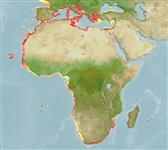>
Eupercaria/misc (Various families in series Eupercaria) >
Sparidae (Porgies)
Etymology: Lithognathus: Greek, lithos = stone + Greek, gnathos = jaw (Ref. 45335).
More on author: Linnaeus.
Environment: milieu / climate zone / depth range / distribution range
Ökologie
seewasser; brackwasser demersal; tiefenbereich 0 - 150 m (Ref. 3688), usually 10 - 20 m (Ref. 37413). Subtropical; 48°N - 35°S, 25°W - 36°E
Eastern Atlantic: Bay of Biscay, Strait of Gibraltar and Mediterranean; southward to Cape of Good Hope, South Africa; around the Canary and Cape Verde Islands (Ref. 3688); and Madeira Is (Ref. 74541). Western Indian Ocean: southern Mozambique (Ref. 3688). Not found in tropical east Africa (Ref. 3198), Red Sea (Ref. 84159) and Black Sea (Ref. 4781, 112870).
Length at first maturity / Size / Gewicht / Alter
Maturity: Lm 17.4, range 20 - ? cm
Max length : 55.0 cm TL Männchen/unbestimmt; (Ref. 3397); common length : 30.0 cm TL Männchen/unbestimmt; (Ref. 3688); max. veröff. Alter: 12 Jahre (Ref. 13716)
Rückenflossenstacheln (insgesamt): 11; Rückenflossenweichstrahlen (insgesamt): 12-13; Afterflossenstacheln 3; Afterflossenweichstrahlen: 10 - 11
Found on the shelf, over sandy and muddy bottoms as well as seagrass-beds and estuaries. Gregarious, sometimes forming sizeable schools. Feeds on worms, mollusks and small crustaceans. Protandric hermaphrodite (Ref. 3688). Flesh excellent (Ref. 3198); sold fresh and dried.
A monandric species (Ref. 55367). In the northern Adriatic, overall male to female ratio was 1:1.62. Sex inversion occurred mainly between 24.1 and 35.2 cm TL and 3.5 years of age (Ref. 55367). Conflicting descriptions of the reproductive style of this species have been reported, including possible gonochorism (Ref. 103751). Also Ref. 28504.
Bauchot, M.-L. and J.-C. Hureau, 1990. Sparidae. p. 790-812. In J.C. Quero, J.C. Hureau, C. Karrer, A. Post and L. Saldanha (eds.) Check-list of the fishes of the eastern tropical Atlantic (CLOFETA). JNICT, Lisbon; SEI, Paris; and UNESCO, Paris. Vol. 2. (Ref. 3688)
IUCN Rote Liste Status (Ref. 130435)
Bedrohung für Menschen
Harmless
Nutzung durch Menschen
Fischereien: weniger kommerziell; Sportfisch: ja
Mehr Information
ReferenzenAquakulturAquakultur ProfilZuchtlinienGenetikElectrophoresesVererbbarkeitKrankheitenVerarbeitungNutrientsMass conversion
PartnerBilderStamps, Coins Misc.LauteCiguateraGeschwindigkeitSchwimmstilKiemenoberflächeOtolithsGehirngrößeSehfähigkeit
Tools
Zusatzinformationen
Download XML
Internet Quellen
Estimates based on models
Preferred temperature (Ref.
123201): 17.1 - 27.5, mean 24.4 °C (based on 224 cells).
Phylogenetic diversity index (Ref.
82804): PD
50 = 0.5625 [Uniqueness, from 0.5 = low to 2.0 = high].
Bayesian length-weight: a=0.01202 (0.01073 - 0.01347), b=3.02 (2.99 - 3.05), in cm total length, based on LWR estimates for this species (Ref.
93245).
Trophic level (Ref.
69278): 3.4 ±0.50 se; based on food items.
Generation time: 4.8 (4.0 - 5.6) years. Estimated as median ln(3)/K based on 12
growth studies.
Widerstandsfähigkeit (Ref.
120179): mittel, Verdopplung der Population dauert 1,4 - 4,4 Jahre. (K=0.24; tm=2).
Prior r = 0.70, 95% CL = 0.46 - 1.05, Based on 3 stock assessments.
Fishing Vulnerability (Ref.
59153): Moderate vulnerability (40 of 100).
Climate Vulnerability (Ref.
125649): Low to moderate vulnerability (31 of 100).
Nutrients (Ref.
124155): Calcium = 72.3 [42.6, 133.6] mg/100g; Iron = 1.06 [0.62, 1.89] mg/100g; Protein = 19 [18, 21] %; Omega3 = 0.417 [0.289, 0.641] g/100g; Selenium = 28.2 [14.1, 49.5] μg/100g; VitaminA = 9.68 [3.47, 23.67] μg/100g; Zinc = 0.831 [0.601, 1.145] mg/100g (wet weight); based on
nutrient studies.
